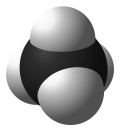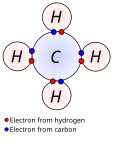Methane
Methane is an organic compound with the chemical formula CH4. It is an alkane with one carbon atom. It is often found as the main part of natural gas. Methane is a greenhouse gas[3][4] 23 times more effective than carbon dioxide. It is also less stable and slowly oxidates by oxygen to carbon dioxide and water.
| Methane | |
|---|---|

| |
Methane[1] | |
Carbane (never recommended[1]) | |
| Other names |
|
| Identifiers | |
| CAS number | |
| PubChem | |
| EC number | 200-812-7 |
| KEGG | C01438 |
| MeSH | |
| ChEBI | CHEBI:16183 |
| RTECS number | PA1490000 |
| SMILES | C |
| Beilstein Reference | 1718732 |
| Gmelin Reference | 59 |
| 3DMet | B01453 |
| Properties | |
| Molecular formula | CH4 |
| Molar mass | 16.04 g mol-1 |
| Appearance | Colorless gas |
| Odor | Odorless |
| Density |
|
| Melting point |
-182 °C, 90.7 K, -296 °F |
| Boiling point | |
| Solubility in water | 22.7 mg·L−1 |
| Solubility | Soluble in ethanol, diethyl ether, benzene, toluene, methanol, acetone and insoluble in water |
| log P | 1.09 |
| kH | 14 nmol·Pa−1·kg−1 |
| −12.2×10−6 cm3·mol−1 | |
| Structure | |
| Td | |
| Molecular shape | Tetrahedron |
| Dipole moment | 0 D |
| Thermochemistry | |
| Std enthalpy of formation ΔfH |
−74.87 kJ·mol−1 |
| Std enthalpy of combustion ΔcH |
−891.1 to −890.3 kJ·mol−1 |
| Standard molar entropy S |
186.25 J·(K·mol)−1 |
| Specific heat capacity, C | 35.69 J·(K·mol)−1 |
| Hazards | |
| NFPA 704 |
|
| Explosive limits | 4.4–17% |
| Except where noted otherwise, data are given for materials in their standard state (at 25 °C, 100 kPa) | |
It is a gas at 25 degrees Celsius at standard atmosphere (a specific pressure).
Uses
Methane is used in gas taps in places such as kitchens, chemistry classrooms, laboratories and more, as it burns very easily because of its simple molecular structure.
Molecular structure
Methane's molecular structure is very simple. It is a single carbon atom surrounded by four hydrogen atoms.
Production
Methane can be made by many chemical ways, but usually is found in natural gas and is obtained by fractional distillation, after it has become liquid.
Methane Media
Covalently bonded hydrogen and carbon in a molecule of methane.
Abiotic sources of methane[example needed] have been found in more than 20 countries and in several deep ocean regions so far.
Testing Australian sheep for exhaled methane production (2001), CSIRO
Bar graph of sources global of methane emissions. Energy sector emissions are from the Global Methane Tracker for 2021; non-energy sector emissions are the average of estimates available from UNFCCC, CAIT, EDGAR and CEDS for 2018 or 2019. Natural sources and biomass burning are top-down median estimates and bottom-up median estimates respectively from the Global Methane Budget for 2017.
References
- ↑ 1.0 1.1 "Front Matter". Nomenclature of Organic Chemistry : IUPAC Recommendations and Preferred Names 2013 (Blue Book). Cambridge: The Royal Society of Chemistry. 2014. pp. 3–4. doi:10.1039/9781849733069-FP001. ISBN 978-0-85404-182-4.
Methane is a retained name (see P-12.3) that is preferred to the systematic name 'carbane', a name never recommended to replace methane, but used to derive the names 'carbene' and 'carbyne' for the radicals H2C2• and HC3•, respectively.
- ↑ "Gas Encyclopedia". Archived from the original on December 26, 2018. Retrieved November 7, 2013.
- ↑ White House Unveils Plans to Cut Methane Emissions March 28, 2014 New York Times
- ↑ Brad Plumer (December 12, 2016). "Methane levels in the atmosphere are now rising at their fastest pace in decades; It's a big problem for climate change". Vox.com. Retrieved 18 December 2016.
| Wikimedia Commons has media related to Lua error in Module:Commons_link at line 62: attempt to index field 'wikibase' (a nil value).. |











